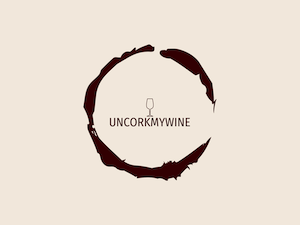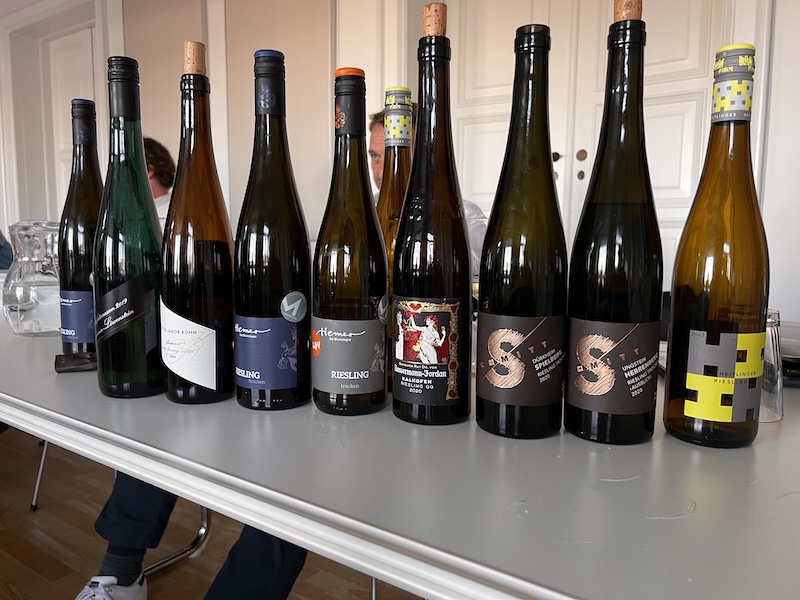13th June 2023. Two-and-a-half hour German Riesling tasting featuring eight high quality wines from five different regions. Focus on regional microclimate and geography to understand how different terroirs affect the wine in the glass. 16 Participants.
The idea
I have been working with this wine club for the past 18 months and together we built up a solid knowledge of German wines and wine regions. Consequently, German Riesling tasting – Germany’s most important wine grape – was about time. We previously had a tasting in this wine club where I focused on Mosel wines, ranging from dry-styled wines to sweet dessert wines. Therefore, this time the focus lay solely on dry Riesling wines to demonstrate how different local microclimates and local terroir affect this grape variety.
German Riesling tasting budget
This German Riesling tasting had a total tasting budget of 6,000 DKK (ca. 800 EUR) for 16 participants. We opened two bottles of each wine, so the participants got quite generous tasting samples. For smaller groups up to 12 participants, one bottle of each wine can be sufficient, reducing the tasting budget to about 4,000 DKK. All values including Danish VAT of 25%.
If you are interested in such a tasting, don’t hesitate to contact me. I always try to accommodate different budgets, as well as individual thematic preferences.
Read below a summary of the regions we focused on during this tasting, as well as some brief thoughts about the bottles opened during this tasting. You will also find links to the websites of the importers providing these wines.
Mosel
Climate
Located at 50 degrees Northern latitude, the Mosel is at the most Northern tip of the area that is suitable for commercial wine production. However, special local geography and terroir make it possible for this region not only to produce great dry Riesling. Further, the region enjoys international recognition for its high-quality dessert wines. The climate in the Mosel region is typically described as cold. The average annual temperature (Koblenz) is 10.0 degrees Celsius with a moderate rainfall of 732mm per year. Winters are cold and harsh and as a result the Mosel River is freezing regularly.
Topography
Along the Mosel River, we find steep South-East facing slopes which are dominated by slate and other rock structures. These slopes allow for good drainage, while the rocky soil helps storing heat throughout the harsh winter season. The river itself also works as a moderating climate impact, while it also has the important function to reflect sunlight onto the vines which are planted on the slopes.
Heymann Loewenstein, Mosel, Riesling Schieferterrassen, 2019 (200 DKK)
I am personally a sucker for Heymann Loewenstein. In my opinion, a German critic who stated that Heymann Loewenstein starts where other winemakers stop, is indeed right. Great entry level Riesling (200 DKK) that shouts out “I am Mosel” from the most northern part, the Terrassenmosel. So, lots of slate in the soil. Ripe apples, mature fruit, oiliness, lots of honey and flowers, and a great minerality and striking acidity at 8.5g/l. Perfect to drink now.
Rheingau
Climate
Rheingau’s importance as a high-quality region might be best illustrated by the fact that the Riesling grape is thought to have its biological origin here. While being slightly more southern than the Mosel region (49.5 degrees Northern latitude), the annual average temperature is very similar (Geisenheim, 9.9 degrees Celsius). Rainfall is with 549mm a year significantly lower.
Topography
In the Rheingau, the microclimate is mostly influence by the Rhine River which runs from West to East along the region’s south wards facing hills. Here, the best vineyards are planted on about 200m altitude to benefit from the sun reflection provided by the river, as well as its moderating temperature impact. The soil is mostly composed of Sand, gravel, loess, and partly limestone provided perfect soil conditions for growing Riesling.
Peter Jakob Kuehn, Rheingau, Riesling Quarzit, 2020 (200 DKK)
When reading in the World Atlas of Wine (Robinson/Johnson) Kuehn is mentioned as a prime terroir producer of the Rheingau area. So, of course, such wines must be included. Outstanding minerality and freshness, lots of green apples, a hint of sour peach, as we are moving south. The 1200 l barrels maturation suits the wine extremely well, creating a complex and delightful Riesling experience. Love it but appears simpler in the glass than the previous wine despite the same price point. Perfect to drink now.
Rheinhessen
Climate
Rheinhessen ist he largest wine producing region of Germany and consequently, one should not be surprised to find a lot of mass production here. However, some quality producers are especially located in the South-East where the fairly moderate climate creates great wines growing conditions. With the Rhine River running in the North and East and Rolling hills protecting the region in the West and South, Rheinhessen has a much higher average temperature than Mosel and Rheingau (Worms, 11.3 degrees Celsius). Rainfall is between the Rheingau and Mosel level with about 639mm annually.
Topography
Quality production is mostly located along the Rhine River on the East side of the area. Here, we find a typical terroir for flat wine regions that are located close to rivers. Lots of sand, gravel, and the highly nutrient Muschelkalk (shell limestone) provide a soil highly suitable for growing high-quality Riesling.
Hemer, Rheinhessen, Riesling Abenheimer Klausenberg, 2019 (190 DKK)
While the Abenheimer Klausenberg in the Southeast of Rheinhessen is not indicated as a top vineyard by Johnson and Robinson, one still must admit that Hemer takes this Riesling very seriously. What is utterly delightful is the fact that they produced a complex and delightful Riesling full of fresh aromas and minerality, as well as striking acidity, that is enjoyable now. And at the price point of around 190 DKK, I prefer this for drinking today over Bassermann-Jordan (see below) which needs some more years in the bottle.
Hemer, Rheinhessen, Riesling Raw, 2018 (170 DKK)
I always include one natural wine in the lineups to challenge this wine club I am working with. Hemer’s Raw Riesling manages to be funky and interesting, while keeping the Riesling grape in focus. The producer itself indicates 5 years drinking window, and yes, it is about there where the bottle must be opened. Unfiltered, good maceration time, lots of yeasty notes. Mature fruit, malolactic explosion, toasted and brioche notes and still a solid acidity giving all the fun the winemaker had in the cellar with this wine. Drink now.
Pfalz
Climate
Bassermann-Jordan, Pfalz, Riesling Kalkofen GG, 2020 (500 DKK)
A generous member of the wine club brought two bottles (three actually, I got one as a gift :P) to the tasting and shared them with us. Usually, I follow the advice of Erik Andersen not to open GGs too early. However, I have to admin (after some previous experiences where too young GGs disappointed me) that the 2020 Kalkofen GG of BJ already shows a great complexity already. That being appreciated, yes, it is still “barnemord”, the wine probably needs another 10 years in the bottle to start showing its potential. Mature, mineral, typical Pfalz herbal notes, decent maturation expressions. Will be outstanding in 10 years.
Weingut Egon Schmitt, Pfalz, Riesling Ungsteiner Herrenberg, 2020 (185 DKK)
Disclaimer: My own import. Ungsteiner Herrenberg and Durkheimer Spielberg are actually located on the same hill in the Northern Pfalz. Therefore, I included the bottle to show the difference in terroir that we get in a Riesling of the same vintage with quite similar vinification. Herrenberg gets morning sun (colder), so a bit more rustic, higher acidity, greener in the nose, and herbal notes that remind of fennel. Great terroir example.
Weingut Egon Schmitt, Pfalz, Riesling Durkheimer Spielberg, 2020 (185 DKK)
Disclaimer: My own import. Ungsteiner Herrenberg and Durkheimer Spielberg are actually located on the same hill in the Northern Pfalz. Therefore, I included the bottle to show the difference in terroir that we get in a Riesling of the same vintage with quite similar vinification. Spielberg gets evening sun (hitter), so a bit more playful, lower acidity, more residual sugar, more mature in the nose, and herbal notes that remind of chamomile. Great terroir example.
Baden
Usually, one associates Germany’s South with red wine production. However, it is important to distinguish between the federal district Baden-Wuertemberg, and the two wine regions Baden and Wuertemberg. They account both for one individual wine region. Wuertemberg indeed is the center of German red wine production. Baden has a rather high focus on white wine, including Riesling. However, the microclimate in Baden is much warmer than in the rest of Germany. The Schwarzwald to the West protects the region from the elsewise moderating and colling Atlantic winds. With the Alps in the South, the region appears to be a heat pot.
Heitlinger, Baden, Riesling, 2022 (170 DKK)
I will not claim that this is great wine. But for the price it delivers a very solid weekday Riesling experience, especially if you are to the warmer notes. And this is exactly why it fits into the lineup for a German Riesling tasting; it shows so clearly how different Riesling from Baden can be due to the much higher temperatures down there. Mature fruit, nearly canned pineapple, lowest acidity of the tasting, pronounced warm summer flowers, a bit candied. An Interesting bottle for heat geeks. Enjoy it now.


